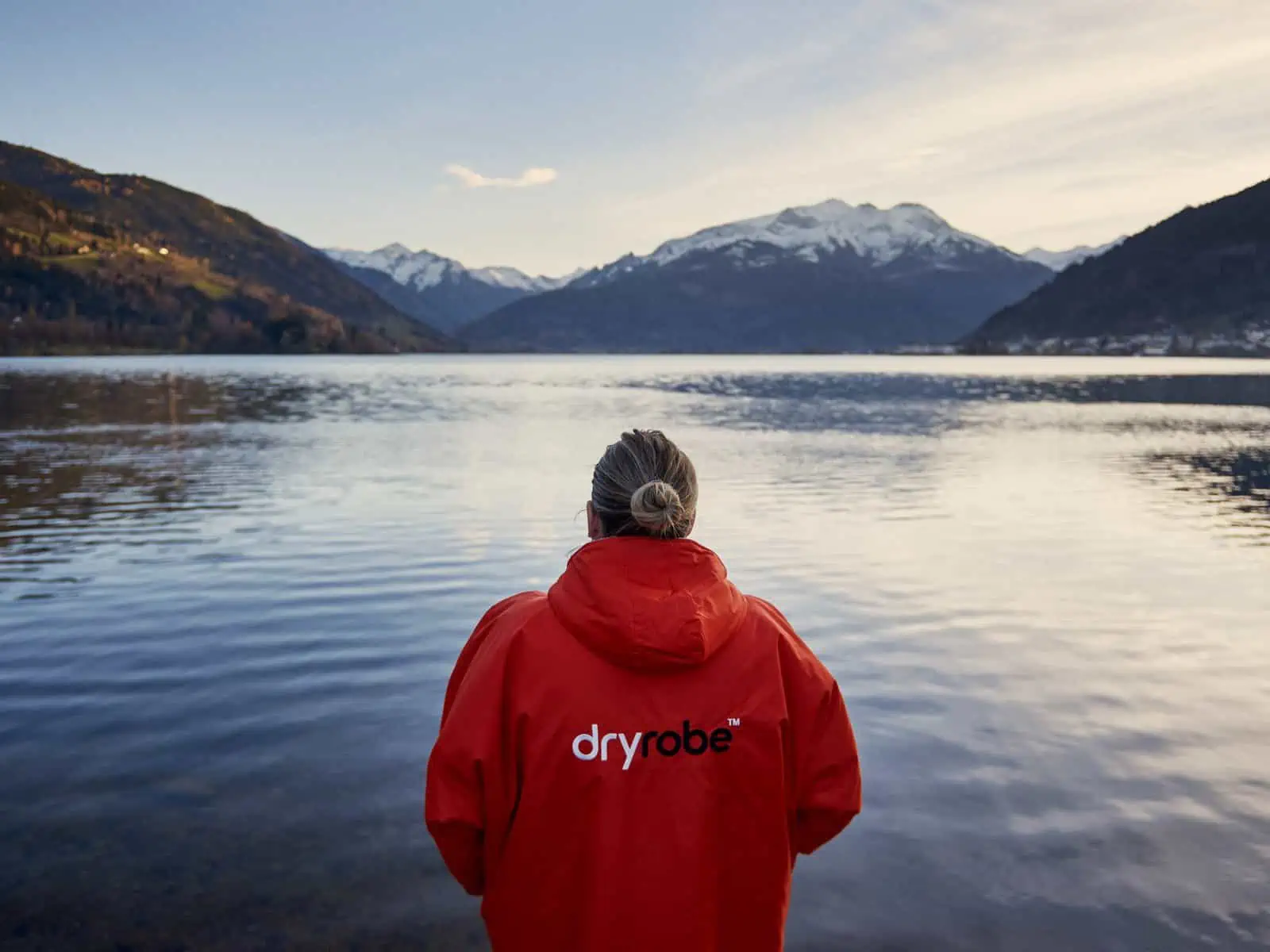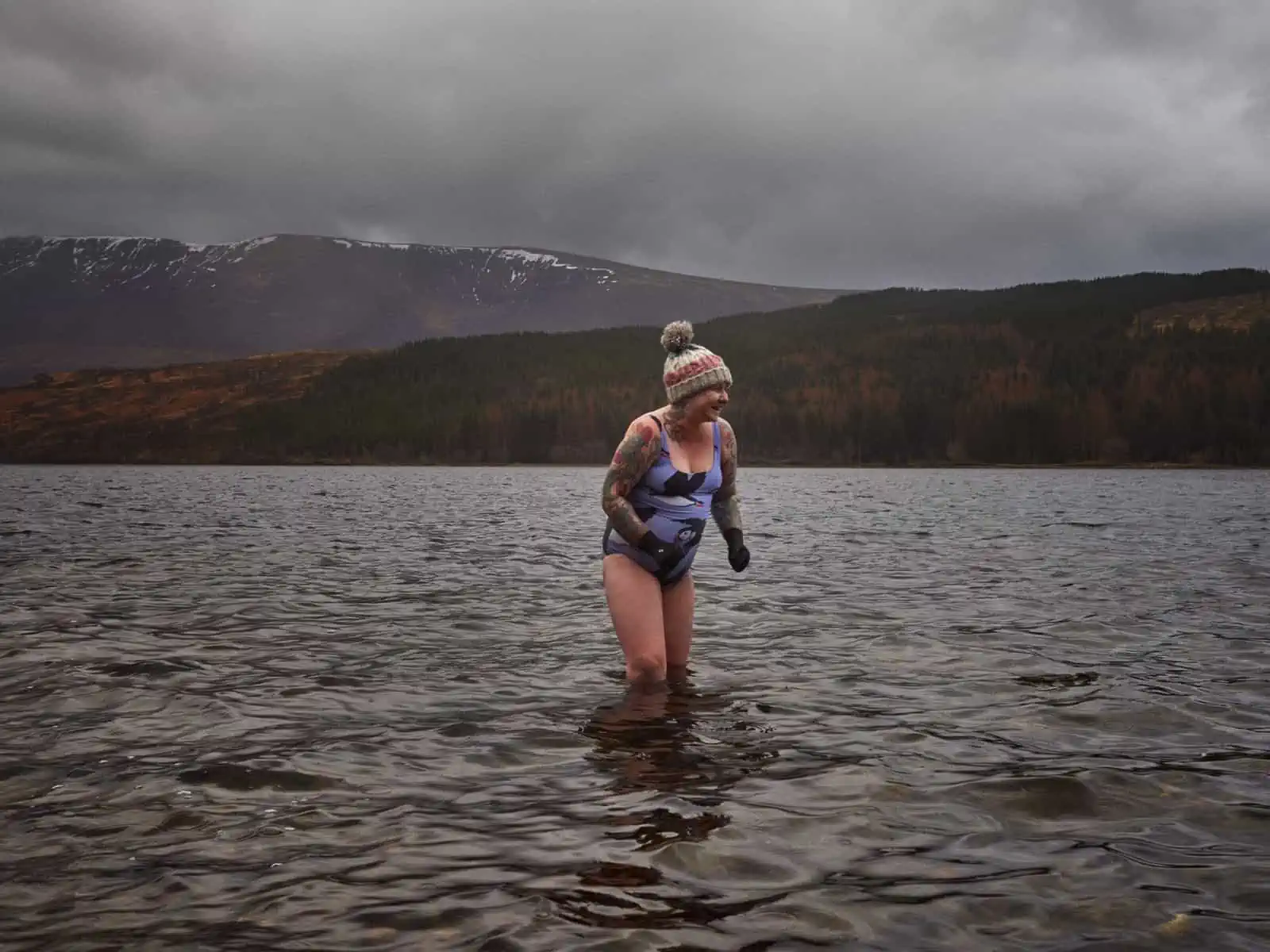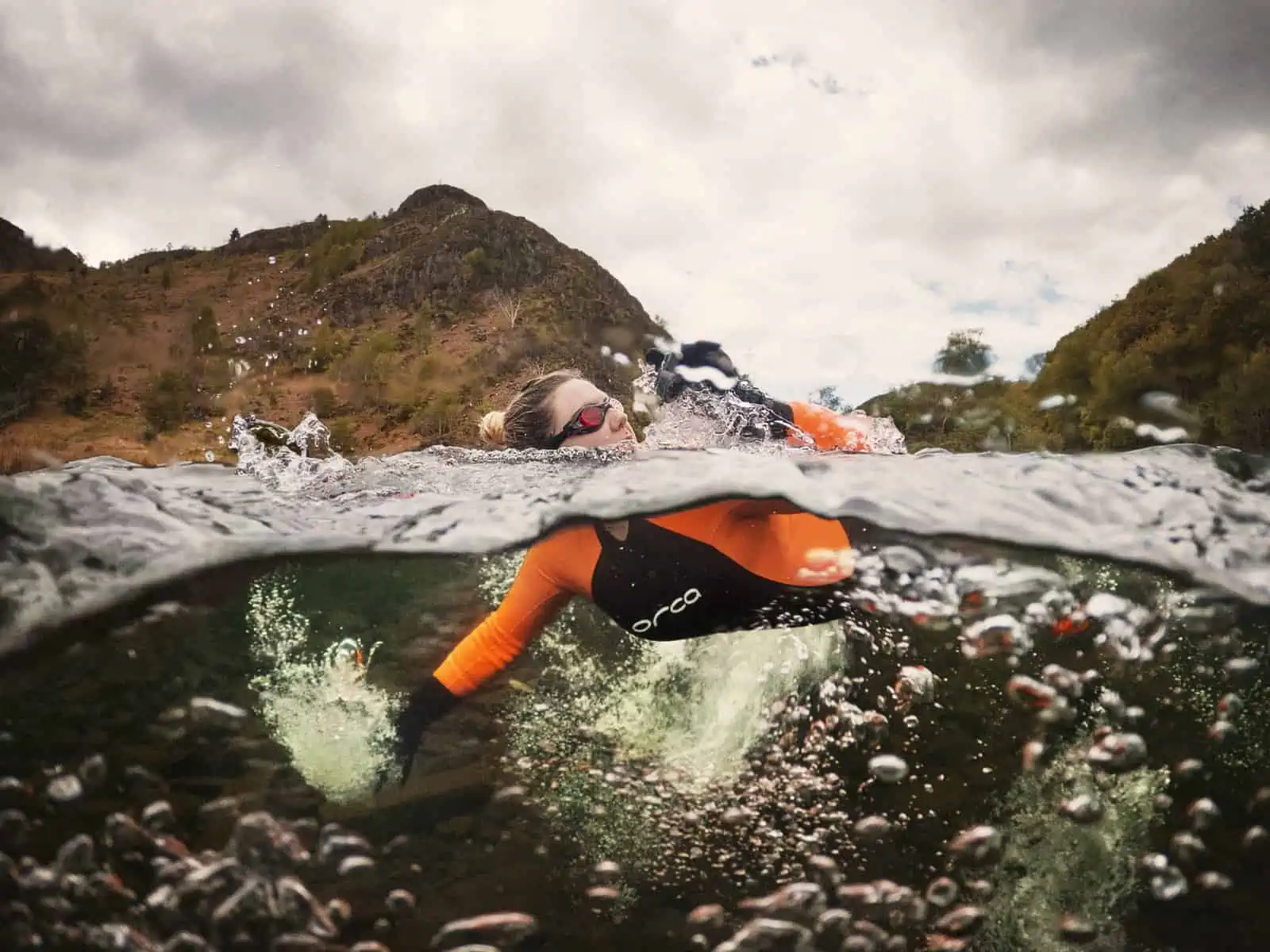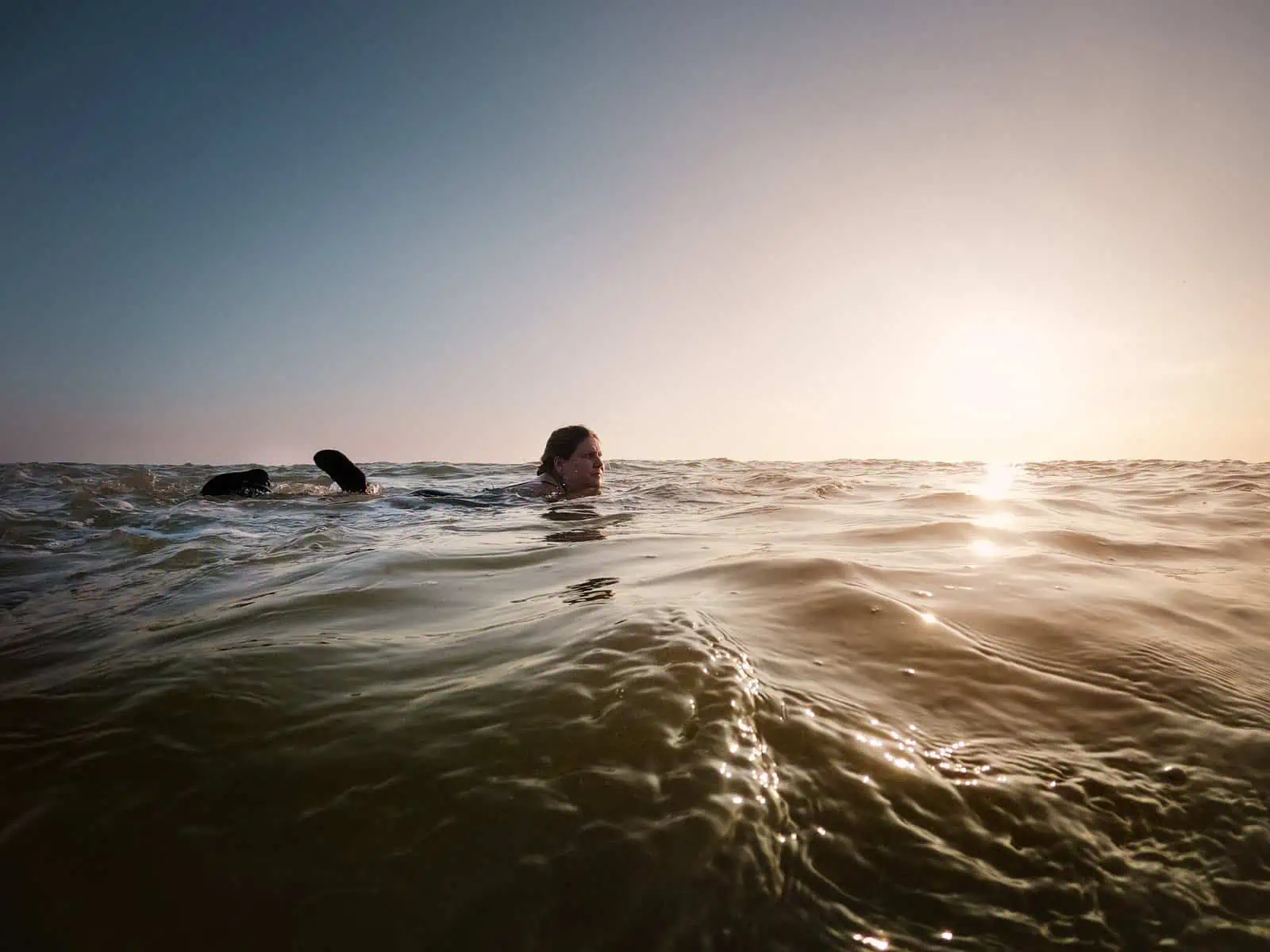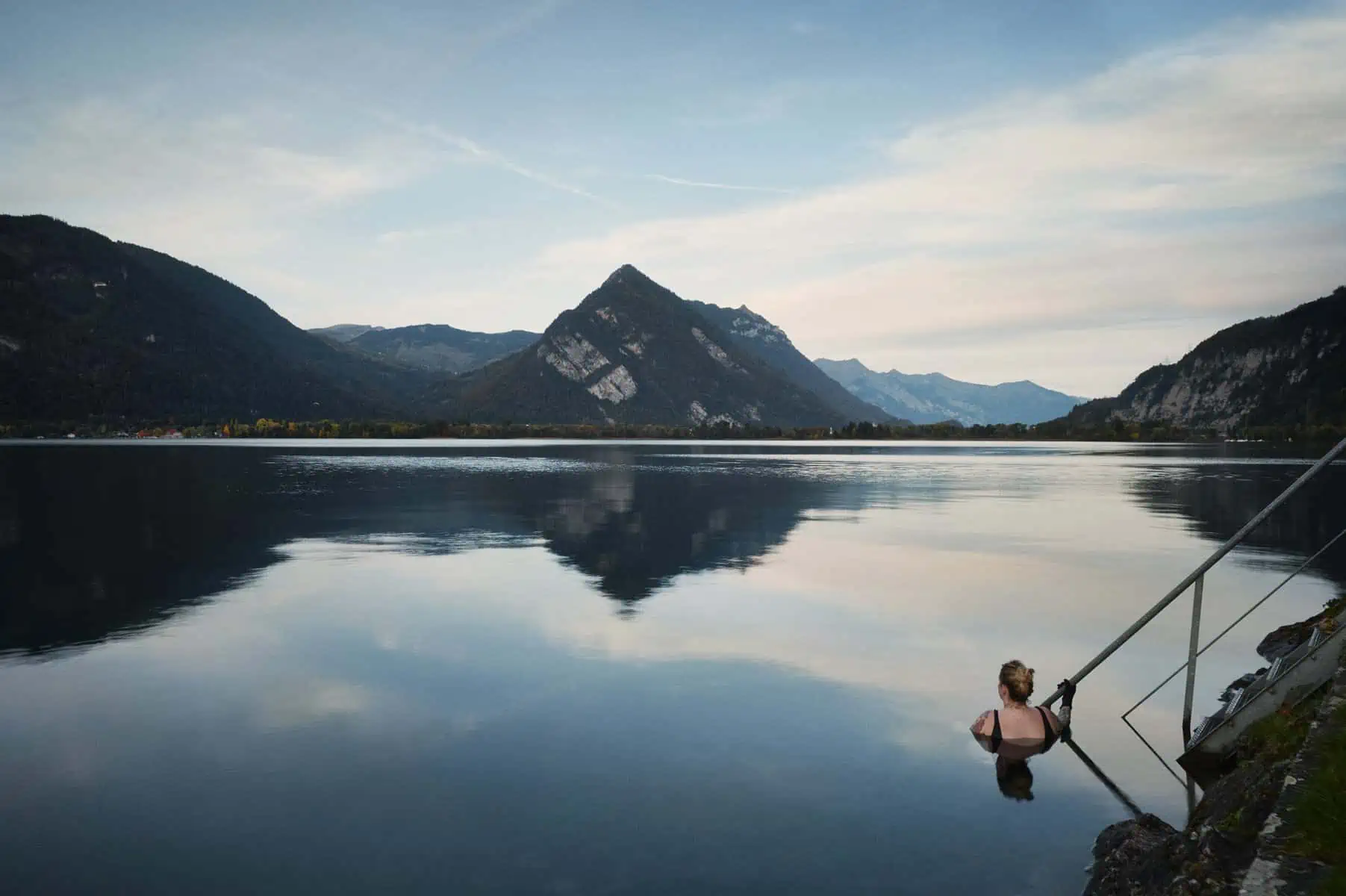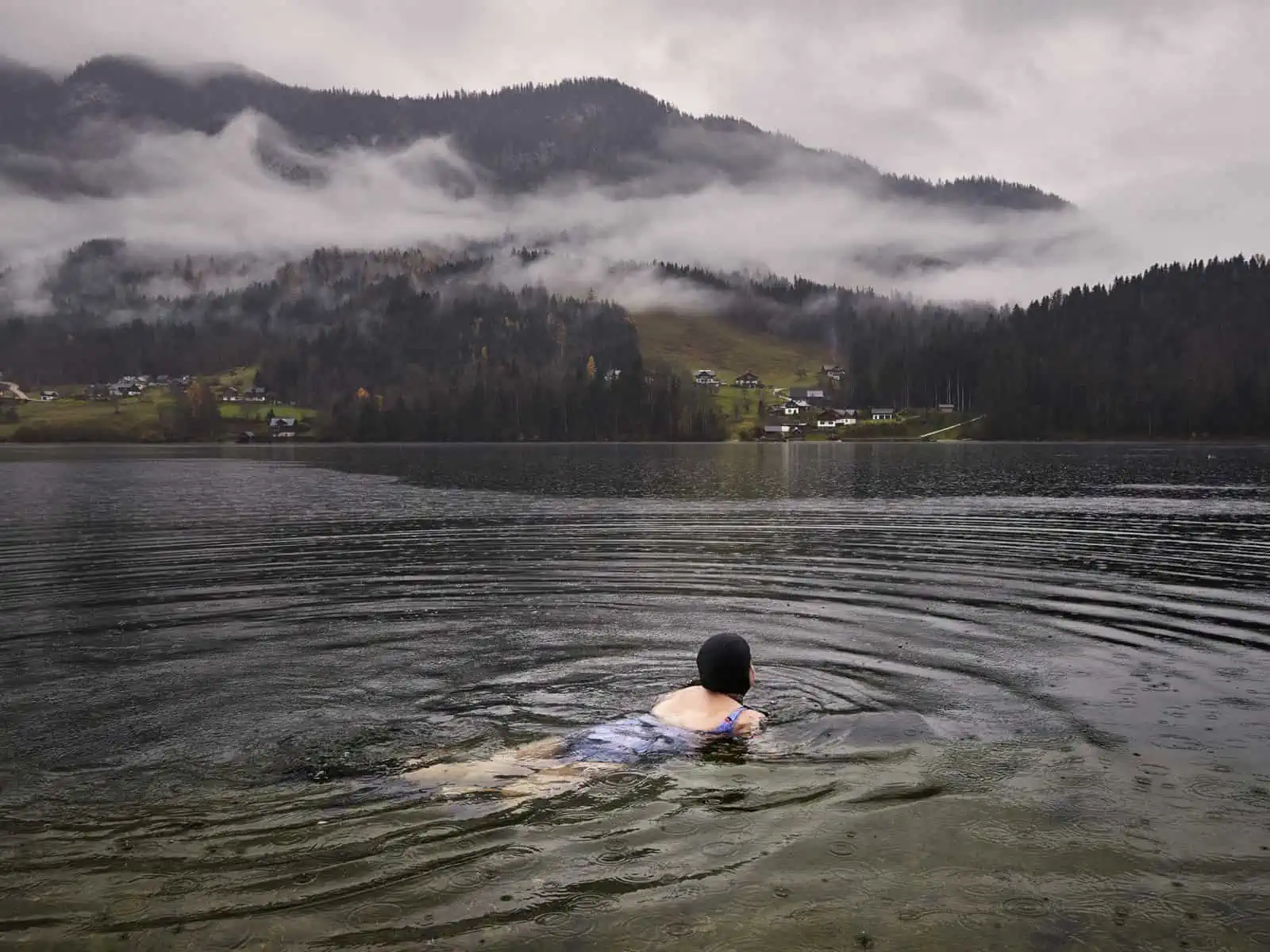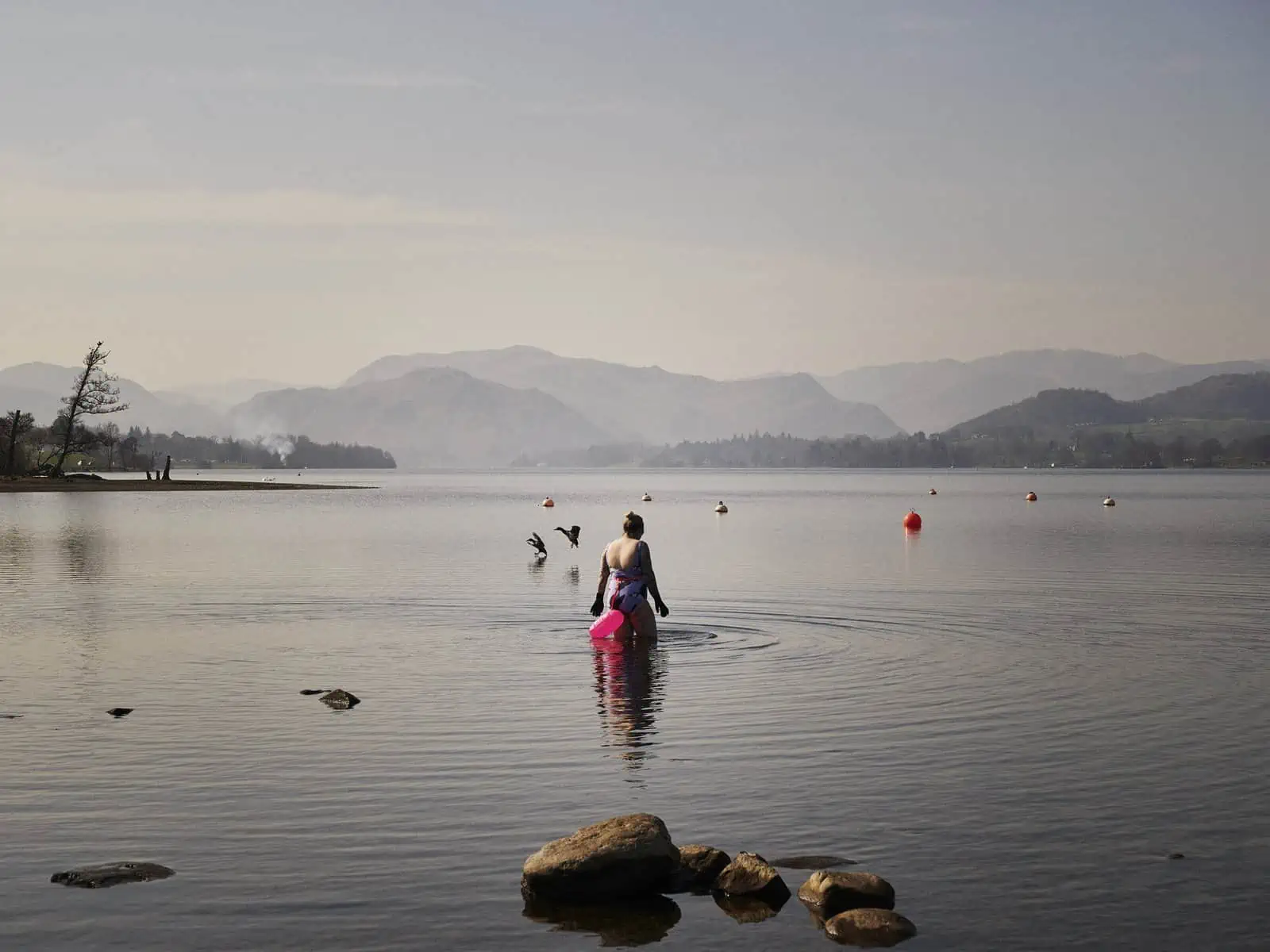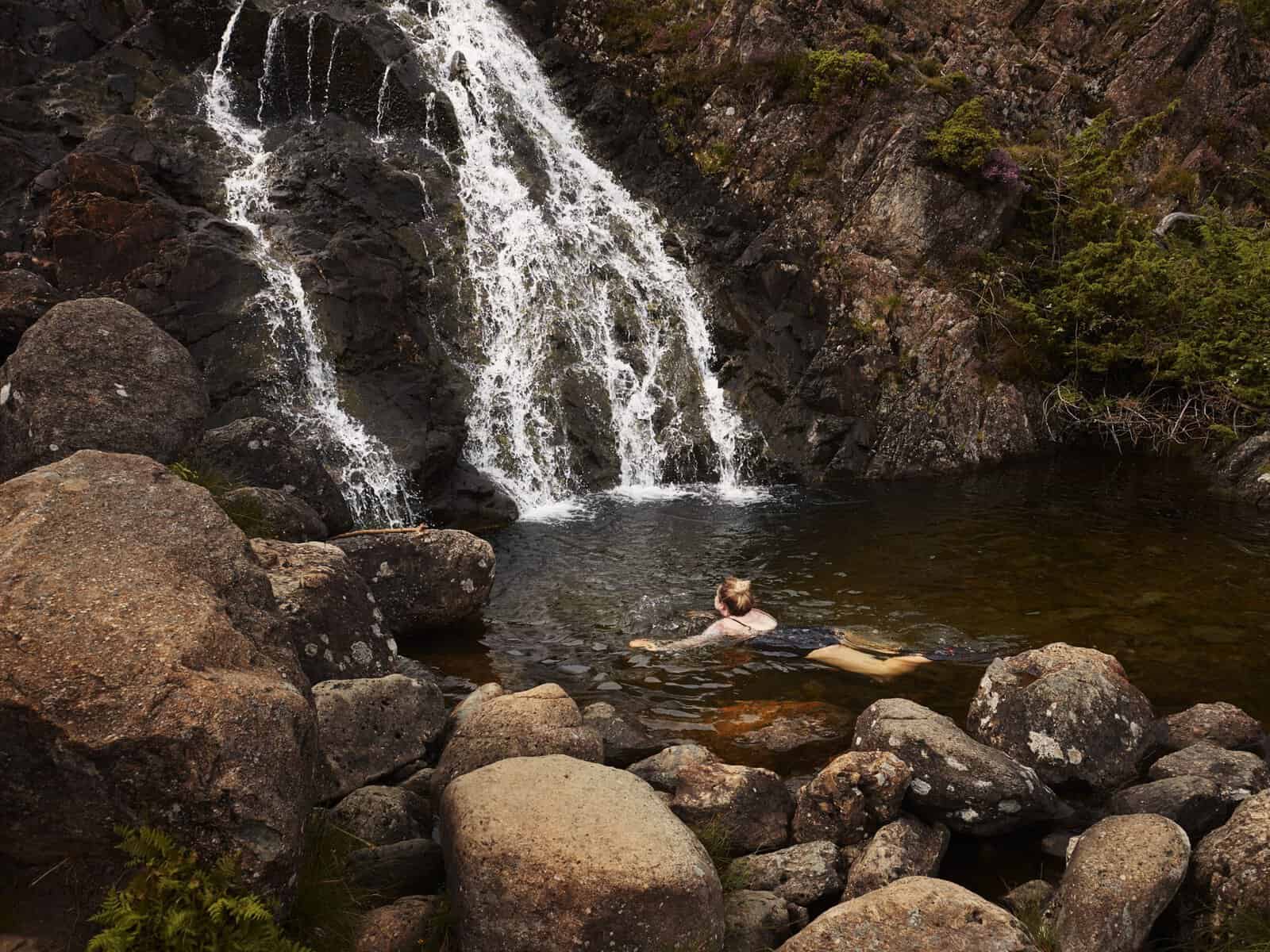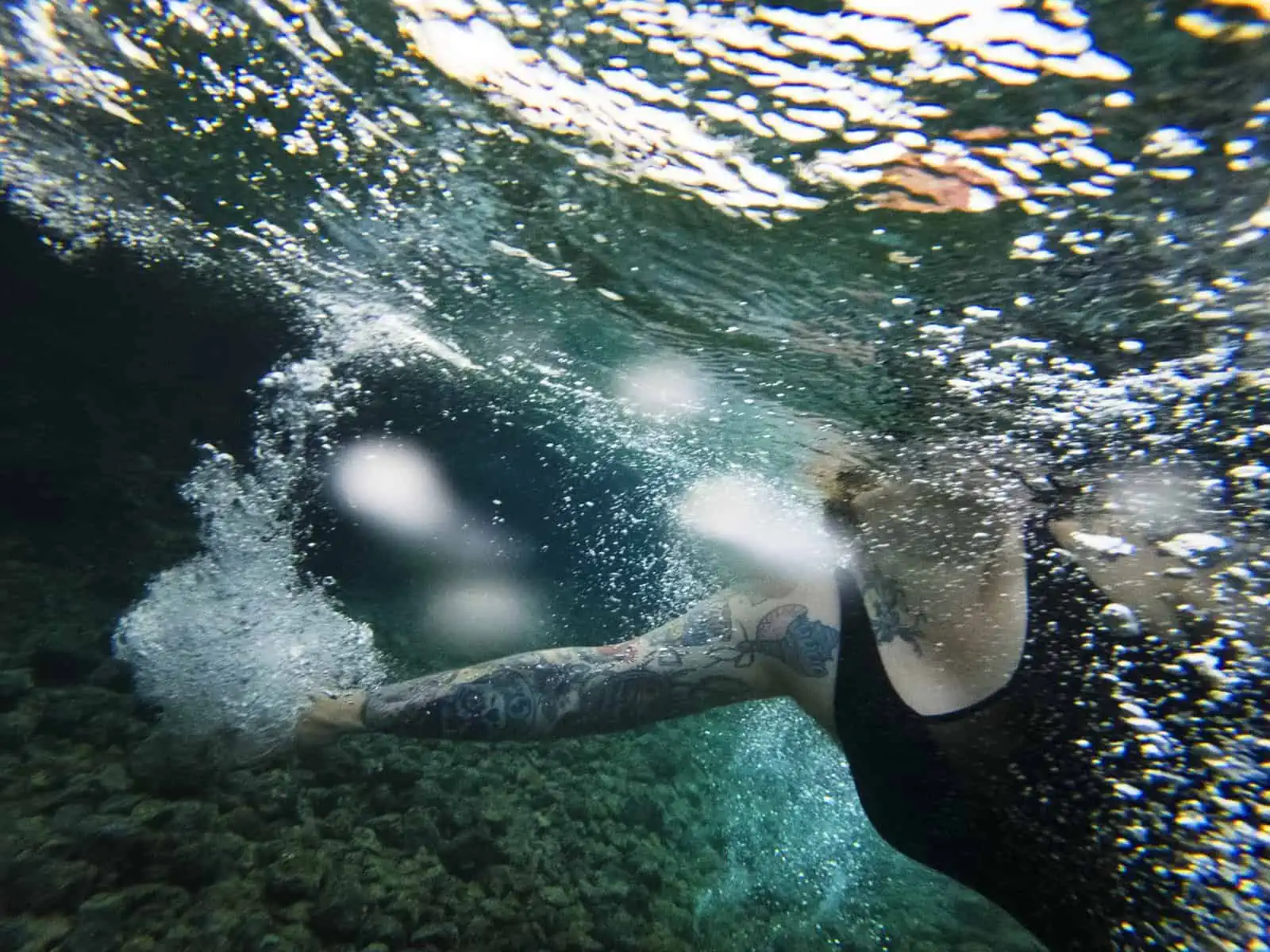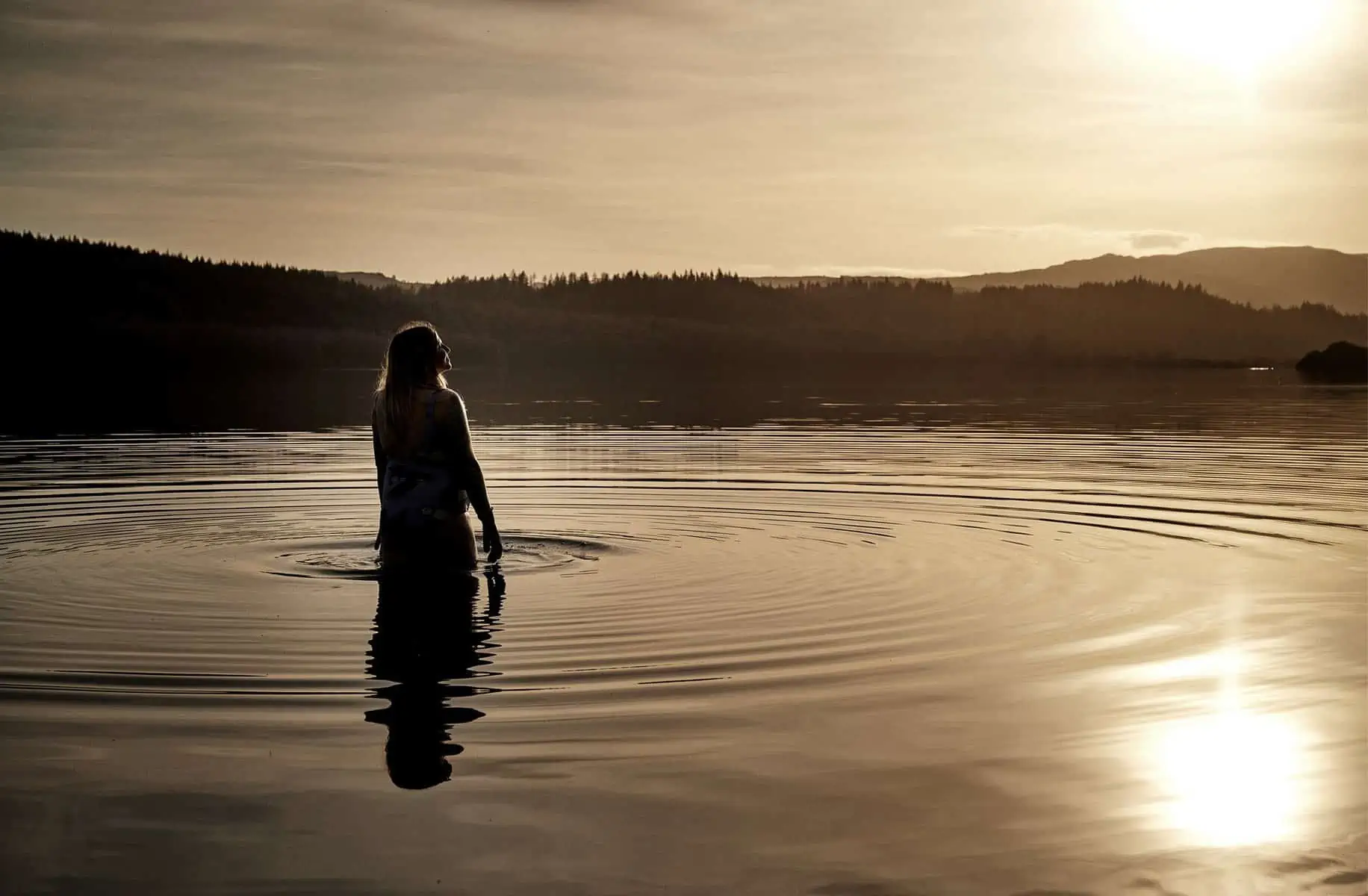I’ve been wild swimming and enjoying cold water immersion for quite a while at this point, and I never knew it would become something that I was pretty much thinking about 24/7! I never saw myself as someone that would enjoy cold water, but now cold water is a very regular part of my time outdoors, exercise and contributes massively to my sense of wellbeing. Wild swimming (or swimming in open, natural water as many still refer to it) has massively increased in popularity – it has a lot of immediately obvious wellbeing benefits and they are becoming more widely documented. This is particularly prevalent when it comes to cold water immersion, with a lot of research being done around the benefits of cold water swimming (and immersion) for the improvement of medical conditions and cold water swimming for depression (you’ve also probably heard of things like cryotherapy, too).
Not only is cold water swimming a great form of exercise, it’s also fantastic for giving you a mental reset. Getting into cold water allows you to be present and create a sort of pattern interrupt in your thoughts (I find it helps me lessen the impacts of my depression and anxiety and clear my mind, even if just for a short time, in a very successful way). It can also be phenomenal for aches, pains. I have ME (Myalgic encephalomyelitis) and with that comes a lot of deep muscle and joint pains. Now I cold water swim because I enjoy it, but also spending time in cold water has become one of my main pain management tools – the amount of benefit I get from this pretty incredible. I know this is similar for many other swimmers I’ve spoken to who are dealing with long term health conditions and chronic illness.
Table of Contents:
- What Gear do You Need for Cold Water Swimming?
- Cold Water Swimming Essentials: Swimwear and Getting Started
- Wetsuits forCold Water Swimming
- Swimming Changing Robes and Coats
- Swimming Socks and Neoprene Boots
- Neoprene Gloves
- Neoprene Caps or Woolly Hats
- Other Essential Gear
- Extras: Cold water Swimming Guide, Advice and Essentials to Consider
- Things to Look Out For and be Aware of With Cold Water Swimming
- Conclusion
Of course, one of the main questions you see a lot is, ‘is wild swimming safe’? Of course, it comes with its dangers – swimming in cold water for longer periods of time is something you build up to. But cold water swimming risks shouldn’t put you off starting – it’s a journey and like everything in the outdoors, if you are sensible and think about what you’re doing, it’s really approachable (I’ll give more tips on this later). There’s something really incredible about the wild swimmer community that you’ll meet when you’re out having a dip too. People just say hello, there’s always a friendly smile at the shared love of something that really does benefit you and make you feel good. I’ve never felt more welcomed than I have since finding cold water swimming!
If you’re just getting into swimming outdoors you might be wondering what to wear for cold water swimming. I genuinely don’t believe you need a lot of fancy kit or anything special to start. Swimwear is swimwear! However, over my time cold water and wild swimming, there are a number of items that have made it into my gear for cold water swimming and make it more enjoyable, safe and enable me to go further.
What Gear do You Need for Cold Water Swimming?
I’ve put this together for you as a guide more than anything. Pick what works for you right now and you can always build up over time the more you enjoy the cold water! One thing to note with everything I recommend, I don’t tie into gendered products. I believe things like wetsuits, swimwear etc should be accessible to people of all genders, and I don’t think that many of the essential gear I’ll be talking about is any different whether its catered to one gender or another!
What Are the Absolute Bare Essentials for Cold Water Swimming Gear?
To start, I genuinely don’t think you need a lot, even though there’s a huge range of products out there. Swimming can and should be accessible. So provided you can swim, well, you’re pretty much good to go to make a start! However, I would always recommend using swimwear such as a swimsuit or swim trunks rather than clothing. I see quite a few people wearing a vest top and a pair of short leggings in the summer. The problem you’ll get here is that the fabrics stay wet for a really long time and become heavy and cold. You’re more likely to feel the effects of the cold in wearing something like this. If nothing else, actual swimwear or a cold water swimming suit is fairly essential. It stays light on the skin and dries a lot quicker. It doesn’t need to be expensive and you don’t need a swimsuit for cold water swimming specifically, but I would recommend getting something that fits well and is made to last. Speedo is a brand you’ve likely heard of – they’re a staple when it comes to swimming and their products are made really well. I really like the Speedo Medley swimsuit – it comes in a range of sizes and is at an accessible price point. If you want to splash out a little bit more and want something that works just as well as a swimsuit for cold water swimming as it would on holiday for example, I love their Razor Dot Swimsuit also. Speedo also make great shorts too. I’d recommend the Speedo Boomstar Splice Jammer and the Speedo Essential Watershorts as good, budget friendly options. You could also look at a combination of shorts and swimming top if this feels better suited for you. I really like the Puma Swim Top.
Round Up: Cold Water Swimming Essentials
Looking for wild swimming locations around the United Kingdom? Check out our guide to 22 Best Places for Wild Swimming
Wetsuits for Cold Water Swimming
It is a personal preference whether you would feel better cold water swimming in a wetsuit or not. I personally prefer to swim in ‘skins’ but many people I know prefer what a wetsuit offers. I love the impact that swimming in cold water with nothing on my skin apart from a thin layer of swimwear material feels. Every time I’ve worn a wetsuit, it just hasn’t quite given me the same feeling, and so I’ve chosen to swim all year round without one. However, if the need arose, and it has from time to time, especially if I want to do a much longer swim in cold water, my wetsuit or a cold water swimming suit is something I’ll absolutely wear. Wearing a wetsuit does come with a lot of benefits though, it means that you’re likely to be able to stay in the water for longer as it provides you a layer of insulation. How do wetsuits work? They’re made of neoprene and when you enter the water, the wetsuit traps a layer of water between the wetsuit and your skin. You body heat warms up the layer of water that is between you and the wetsuit, meaning that overall you stay warmer for longer and provides extra warmth especially in colder water. They’re great if you’ve got your sights set on a long swim for example. It can also just make it that much easier to experience the cold. They provide extra buoyancy too. I generally find when I wear my wetsuit, I don’t need to acclimate to the water for quite as long, finding it much easier to swim off. However, not all wetsuits are made the same, and the good ones do cost a good bit more. With that being the case, I thought it would be helpful to go into more detail on this.
What Should I Look for in a Wetsuit?
If you’re serious about cold water swimming I would recommend investing in a wetsuit that is going to last. In recent years there have been a lot of much cheaper models coming out from high street retailers, and whilst it’s great to have these more accessible options, they aren’t always fitted properly and they often bunch up and are a lot looser in areas you don’t want them to be. This isn’t just a styling thing, this is about heat – if there are a lot of loose areas of fabric, you won’t feel the benefit of wearing a wetsuit in the way it’s intended. My wetsuit is by a brand called Orca (I received this as a previous gifted item, but had no obligation to review it) who specialise in premium wetsuits. It is an investment, but as a company they’re really sustainable and are passionate environmentalists, which is something I love. Their wetsuits are incredibly well fitting and make a serious difference when it comes to cold water. Make sure you measure yourself correctly against the sizing guides provided and get something that fits like a glove rather than something you think will be too big – you want it to feel skin tight. If it doesn’t feel right when you put it on, take the time to send it back and get a different size. Don’t settle for something that doesn’t fit perfectly with a wetsuit. I particularly love the Orca Openwater Core Thermal Wetsuit because it’s thermal and it makes a big difference to the time you can spend in the water. My partner has one of these and loves how long can spend in the water whilst wearing it. I also would highly recommend the Orca Openwater Core HiVis Thermal Wetsuit too. It looks amazing with bright orange arm details and fits incredibly well. If you’re looking for a more budget option that gets the balance between price and usability, I’d recommend the Osprey Winter Wetsuit.
Wetsuit Recommendation Round Up for Cold Water Swimming:
Swimming Changing Robes and Coats
If you’ve ever tried to get changed on a beach by just using a towel around you and had it fall down multiple times, well, it isn’t a nice experience! With cold water swimming you want get warm afterwards as soon as possible – and something that helps a lot with that is getting dry! If you’re wrestling with a traditional towel, you’re going to be more focused on having it not slip down rather than getting changed. Every time I tried to do this at the start of getting into cold water swimming, I felt miserable as I was just so cold! When I moved onto a changing robe things were a lot better. I personally think this should be at the top of your list when it comes to cold water swimming gear as it makes a big difference to your experience. A traditional changing robe looks kind of like a giant hoodie which comes down to your knees in some cases. Its usually made of an absorbent fabric – either quick drying towel or towelling robe which helps you to dry off as you pop it on. There are a lot of cheaper options you can look at if you’re on a budget, but some of the really cheap options I’ve found really don’t seem to last long sadly. I think one of the main reasons for this is the stitching – a changing robe is something you’ll be pulling around all the time, so there are a lot of areas that can weaken and come apart if the stitching isn’t great quality. If you’re on a budget, I’d recommend the Hiturbo Changing Towel as a cold water swimming changing robe – it works really well for summer and is pretty lightweight. So if you want to head to a mountain lake where you need to fit everything in your backpack, it’s pretty ideal. However, I really recommend dryrobe and the products they offer. I also love their charitable giving and programs – such as the Warmth Project which supports charities and non profits who are promoting the benefits of being outdoors. For all transparency, dryrobe did send me some product for my wild swimming project in Austria, but I had no obligation to include them in this review or post about them. I’m choosing to because after testing them ‘out in the wild’ pretty rigorously, I genuinely think they are incredibly well made and deserve the reputation they’ve gained. I tested the dryrobe Advance. I think it’s a really valuable, but they are expensive, so buying one will be an investment for many people. They’re also pretty bulky – this is probably essential for them to function as well as they do. However, you can also get the dryrobe Compression Bag. It’s a great way to store the coat and keep size down – this is particularly handy for travelling and would potentially fit inside a backpack depending on the size of bag you have. The dryrobe Advance long sleeve essentially works like a cold water swimming coat. It is fully waterproof and windproof on the outside and on the inside it has a fast drying lining. What I’ve found since I have upgraded to a swimming coat style dryrobe is that I’m much warmer. They also just make things easier, because it stays dry, you can wear it on the way to your swim, so you’re not having to carry loads of excess stuff, and even after you’re dry from your swim, you can keep it on over your clothes and it’s still dry. I must admit, I was a bit dubious about them for a while as I didn’t know how it could stay dry even after you’re changed and you’ve used it to dry out. However I was amazed how long the dryrobe Advance actually stays dry for. I’ve worn my robe all day from start to finish, changing into and out of my swimwear up to three or four times and it’s still dry. What’s more is its really helpful before you swim as it allows you to build up your body heat and when you first get out of the water, it means you’re able to take a second and get dressed at a slightly more relaxed pace and provide extra warmth to your cold body. For my recent projects, I’m not sure I could have stayed in the water for that long without it. In summer, something like the dryrobe Towel works really well and the quality stitching and overall finish means it is built to last – so you would likely only need to buy once if you look after it. The dryrobe Towel also works great as a slightly more budget option than the dryrobe Advance too. They also offer some pretty cool accessories too like the dryrobe car seat cover and the dryrobe seat cover which offers a pretty nifty way of keeping everything dry after – especially in summer where you might want to go straight from swimming to the car.
Round Up: My Personal Changing Robe Product Recommendations:
Swimming Socks and Shoes (Neoprene Booties)
One of the things that put me off wild swimming for quite a long time was because every time I’d been swimming in nature before, I didn’t like the feel of rocks on my feet! It wasn’t so much that it would make me squirm, but it would make my feet hurt and really stop me from wanting to do it – there are a lot of sharp rocks and stones that you’ll encounter when getting into the water sometimes! Once I invested in some cold water swimming boots, I really saw a difference and to be honest, that is when my time in the water started taking off as it essentially felt like I was wearing a shoe to get into the water and I could barely feel anything around me. However, the added benefit of this is the fact that swim boots or swimming socks are made from neoprene so they’re great for adding an extra layer of warmth. You loose heat from your extremities, so keeping your feet warmer is a great way of allowing yourself to stay in the water that bit longer, or even enjoy the time you are in the water more. When you’re constantly thinking about how cold your feet feel, you’re not going to be enjoying the experience as much. As the boots and shoes you’ll likely find are made of neoprene, it’s worth looking at the neoprene thickness stated by the manufacturer – for example a 3mm boot is going to be less warm than a 5mm. For winter, I think that boots or a neoprene swim sock are pretty essential to my enjoyment, and would really recommend getting some. Of course, many people prefer to swim all year without anything on their hands and feet, but I really do think they make a positive difference – and I’m sure you’ll notice the benefit too! Like everything with wild swimming, you can spend loads on swim boots or socks, but you don’t need to. The one thing I would recommend is making sure that they fit properly. I have a pair of swim socks by Orca which are actually a lot warmer than my boots (although I prefer my boots as they have the reinforced sole so I feel less under my feet) but the socks fit more snuggly, which is why they feel warmer. In terms of boots, I wear the SEAC Basic HD 5mm Diving Boots. They were the first pair I bought a few years ago and they’re still going strong! I also wear the Orca Open Water Swimming Socks when I need something to keep me even warmer in particularly chilly water.
Round Up: My Personal Recommendations for Cold Water Swimming Shoes and Neoprene Socks: Round up: my personal recommendation for cold water swimming shoes and neoprene socks:
Neoprene Gloves
The same logic applies for swimming gloves as it does for swimming boots. However, the difference being that for most of the summer season and for autumn swimming, I don’t tend to wear them as much, but I always bring them on a swim just in case as you never know if they might help you enjoy the water that bit more. In winter, though, they are always on – I find I can’t really swim very well without them. I struggle with cold hands a lot as it is, so these make it much easier for me. The first pair I bought were the QKURT 3mm Neoprene Wetsuit Gloves, which are still going strong and I would recommend them highly as a more budget friendly option.
Swimming Gloves Recommendation Round Up:
Neoprene Caps or Woolly Hats
Another item that I think is really helpful for winter swimming is wearing a neoprene swim hat. You loose a lot of heat through your head so it can really help when it comes to keeping as warm as possible in the water. A neoprene swim hat or cold water swimming cap can be amazing at keeping the heat in, but they can feel quite tight on the head – as they are designed in a similar way to a wetsuit, with the tightness being important to keep the warmth in. I sometimes get a feeling like I’m being given a facelift when I wear mine, which isn’t the most relaxing feeling! None the less, they do provide an extra layer of comfort for the winter that makes a big difference (I don’t think you really need one so much in the summer). I really like the Orca Neoprene Swimming Hat – I’ve been using this for quite a while and it keeps my head noticeably warmer than without, particularly in really cold temperatures. They also help to stop water getting in your ear canal. You may well have seen cold water swimmers wearing woolly hats for their swims too – this is another great option and something I love myself as it feels quite different and snuggly. You can get specialist woolly hats for wild swimming, but essentially, all these are is a waterproof bobble hat. A waterproof bobble hat is a great idea for winter anyway, as it doesn’t get soaked when it rains, but they’re great for swimming and really do keep your head warm. I have one of the Waterproof GM Apparel Stormproof Bobble Hats – it’s really nicely lined and I love it both for swimming and wearing elsewhere too, plus it’s really reasonably priced.
Round Up: My Personal Recommendations for Neoprene and Woolly Hats:
Hand and Boot Warmers
It’s not essential, but something that I’ve found really helps me is having warm boots/shoes and warm hands as soon as possible after my swims. Recently, I found USB rechargeable hand warmers and it’s been a bit of a game changer! They’re great to put in your shoes or boots so that when you put your shoes back on afterwards, they’re toasty warm (or just warmer than your feet will be post swim). They really do make a big difference and I think they’re well worth the money! They can also help with numb hands and to get a range of motion returned more quickly. I’ve been using the Bosoner Hand Warmer – and would really recommend them for that added bit of warmth.
Hand and Boot Warmers Recommendation Round Up:
Tow Float/Swim Buoy
Depending on where you’re planning to swim, a tow float can be an essential thing to give visibility. I generally wear my tow float when I’m swimming in rivers or lakes where there might be boats but also in areas and on shorelines where there could be smaller traffic such as paddle boards and canoes too. They’re usually an inflatable device, kind of like the arm bands you would have used when you were learning to swim except their fasten around your waist with a waist belt and trail behind you as you swim. I don’t believe you need to wear one all the time as they can get in your way, especially if it’s windy. If you’re swimming in a body of water that is closed to boats/water traffic or you know the area well and are sure it doesn’t get frequented, you’re likely fine without, but always be mindful and careful. However, if its busy, I would recommend you use one, they’re also a good idea if it’s foggy. If you’re planning on doing a longer swim, they can also work really well as a dry bag if you get one that seals in such a way as to provide a bag type structure. They’re great for keeping snacks or supplies in for that reason. However, the more simple ones are often the cheaper ones, and I don’t believe a float is something you need to spend a lot of money on. I’ve been using the Jodsen Swim Buoy for years and it’s still going strong with no problems!
Tow Float Recommendation Round Up:
Extras: Cold Water Swimming Guide, Advice and Essentials to Consider
If you’re new to wild swimming and cold water swimming, you might have been put off or daunted – but the truth is, wild swimming is not something to be scared of if you are safe and know what to look out for. It really is just common sense, but here are some of the key areas you should consider before your cold water swim. I wanted to break this down for you in a way that isn’t daunting and just gives you everything you need to know in a non judgemental way to enjoy your time in cold water more!
Safety and Knowing Where to Swim
As you can likely imagine, cold water swimming safety is really important. Taking these points seriously can avoid many of the accidents you see reported in the media. However it doesn’t need to be overwhelming. The key points here are:
- Know your limits: What does that mean? Start small and build up. If you’re new to cold water swimming, go in for a few minutes at a time and you can increase from there when you have more confidence. When I first started, I could spend very little time in the water, and now I’m much more experienced, I know what to expect from the whole process and where I can push myself. That only comes over time, and it’s a lovely journey. As it gets colder through the year too, you really need to be getting out before you think you need to. Nobody can tell you the exact time to stay in the water, as that is such an individual thing, but trust your body and air on the side of caution always. We’re also often talking about dips not distance when it comes to cold water swimming. You don’t need to be a hero or make it a competition against yourself or others, it’s something where you can really just enjoy it for you, and the benefits it gives you!
- Don’t just jump into cold water: This is where the majority of accidents happen – when people don’t acclimate and get cold water shock as a result. It takes your body a little time to adjust to the colder water. Water temperatures can vary wildly through the year too. Sometimes being a lot colder than you might think in summer, too! If you just jump in, as inviting as that might seem on a hot day, it’s not a good idea. If you want to jump in, get used to the water first and then jump in after you’ve had some time in the water to acclimate.
- Assess the area: Are there signs telling you not to swim? Is there a lot of water traffic? How is the water quality? These are all fairly obvious, but in terms of water quality, this can look very different from place to place. Don’t just use other swimmers in the water as a reason to get in either. In terms of water quality, one thing to look out for is blue green algae – which is an irritant, but is usually only present in the summer months. If you’re sea swimming, how is the tide/current/waves? If you’re new to it, stay close to the shore of all bodies of water when swimming and see if you can spot easy entry and exit points before you get in the water. Knowing how you will get in and out will give you much more confidence and make you a safer and better wild swimmer. In winter, be mindful of ice – whilst you may get some amazing pictures, ice swimming and ‘breaking the ice’ for swimming is something to be approached with caution. Ice can scold the skin, create rashes and even cut you, so really asses where you’re going to swim before you do it. If you’re keen to swim in icy water try to go with someone or a group who’ve done this before and can help you safely access the water for an extreme cold water dip!
Acclimatise to Cold Water Swimming
If you’re wanting to give wild swimming a try, you might be wondering, how do I prepare myself for cold water swimming? It is amazing what our bodies can do – when you first enter the water, you’ll likely feel really cold, but after a while, you will start to get used to it. I love this part, as there is always this build up of anticipation of how cold the water will be there. Then there is the getting in and overcoming it, putting mind over matter and realising just how strong we are. This was quite a challenge for me when I first started swimming outdoors, but the more I’ve done it, the easier it has become. Trust the process – it’s all part of it! You should always take it slow and steady when it comes to getting in the water. An easy access point, such as a slow grade downwards into the water along a shoreline works really well. This will allow you to sit in the water and get used to it. If you acclimate slowly and properly, you will likely be able to avoid cold water shock. I always acclimate in a number of stages and is the best way I’ve found to get acclimated quickly. It goes like this:
- Breathe in as you go down to waist height in the water. Breathe out. Stay there for a few seconds until you feel your breathing is back to normal.
- Breathe in as you go down to between waist and chest height in the water. Breathe out, repeat as before.
- Breathe in as you go down to chest height in the water. Breathe out, repeat as before.
- Breathe in as you go down to shoulder height in the water. Breathe out, repeat as before.
By the time your shoulders are covered by the water, you will have overcome the worst of the cold shock you’ll experience. There is no hard or fast rule as to how long it takes someone to acclimate. If you’re still feeling cold or your breathing is off, practise breathing in two short breaths and then one longer breath. This will help to warm you up considerably as you start to swim and enjoy your cold water swimming experience more. Once you are acclimated to the water, this is when the real benefits will kick in. Another tip: I usually find putting my head under the water (anything below the ear canal area) makes me feel colder too.
Wear the Right Swimming Gear
I’ve outlined above my favourite gear for cold water swimming, but I think more important than anything when it comes to what you wear when swimming is that it fits well. If you’ve decided to go for a wetsuit, make sure it’s snug and that its close to the skin so you get the best benefit from it. With swimwear, make sure it fits you well and avoid wearing clothes that aren’t designed for water, such as vests and normal sportswear leggings. These will retain water a lot more than specific swimwear will and are not a good idea. Everything else you use for cold water swimming is based on where you swim (for example if you need a swim buoy/tow float or not) and preference. I genuinely think there is too much out there that suggests you need to most expensive kit for everything, or otherwise you’re not doing it safely. That simply isn’t true, as many cold water swimmers will tell you!
Have Warm Dry Clothes Ready
You don’t want to be getting dressed with clothes that are wet through. If it’s raining when you go swimming, I’d recommend keeping your clothes tucked under something waterproof on the shoreline. A dryrobe Advance is really good for this. I usually leave mine over the top of my clothes whilst I’m swimming. However, anything waterproof will do, but make sure you weigh it down so there is no chance of it blowing away. If you’re swimming in the colder months, it’s also a good idea to make sure you have some warm layers to put on when you come out of the water, especially with colder air temperatures. Loose fitting is always best – I usually wear a hoody and joggers, sometimes lined hiking trousers that are easy to get on and off. You don’t want to be fiddling with things when your hands are cold. If you have long hair I’d recommend tying it up and inside a hat in winter – having cold wet hair in cold air temperatures can give you a chill (and your hair can also freeze). Leggings, sadly can be a nightmare to get back on when you’re cold. A hat, gloves and scarf can also be great too and you’ll want to bring something to put your wet gear in. This doesn’t need to be anything special, but I use a dry bag to keep everything that’s wet sealed up.
The Order to Get Dressed That Will Help You Get Warm the Quickest
I also have developed an order in which to get dressed that I feel works the best:
- Bottom of trousers first (around the ankles)
- Socks
- Shoes – once you have your shoes on you can move around a lot quicker and easier!
- Pull up your trousers and pop on the rest of your clothes
When you’re getting changed as well, leave your clothes piled in the order you’re going to put them back on. If possible, leave them neatly folded up and the right way out. You might think this is overkill, but it’s much easier to get your clothes on when they’re the right way out when you’ve got cold hands!
Warm Up Slowly
You might think that you want to get as warm as quickly as possible when you’ve finished cold water swimming, but you need to be mindful and careful about this. If you warm up too quickly, you can get chillblains which can actually be really painful. Don’t worry too much about this – it isn’t to put you off, I just mean try not to run immediately for a steaming hot shower. Give your body chance to warm up a little bit first before you try to warm up more and more. You may find a hot drink helps too! Some swimmers I know also bring a hot water bottle, which sounds like a great idea, but it’s not something that’s ever worked for me.
Things to Look Out for and be Aware of With Cold Water Swimming
How You Feel in the Water and How Long to Stay in
A wise swimmer said to me a while ago ‘get out wanting more’ and I think this is a really true statement. When thinking about how long to stay in cold water swimming, you should never put yourself at risk and always make sure you get out not having reached your limit. Be really mindful of how you feel in the water. Over time, as I have built up my tolerance to cold water, I have a much better idea of how long I can spend in it. However, your tolerance isn’t just based on your experience level, it can also be based on the ambient temperature, or even how you feel that day and changes in your body temperature. Don’t judge yourself based on a previous swim or a goal you want to get to, and if you’re going to push yourself, do it in micro stages over time. If you start to feel really blissful in the water or euphoric, you should be getting out. If you start to shiver a lot, you should get out. Equally, if you start to feel really warm, weak or cramp up you might be experiencing cold water swimming fatigue, so you should get out if you start to experience this too. it’s always a good idea when you’re new to cold water swimming to stay by the shoreline for easy exit. You will feel colder when you get out of the water, so base how long you spend in the water on how you react the first few times and build from there. You need to be able to still get dressed! It’s common sense, and you’ll be hyper aware of what’s going on in your body, so if you keep this in mind, you’ll be able to stay safe and enjoy your swim.
After Drop
After drop is basically where your body temperature continues to drop even after you get out of cold water. What this means in reality is that you can end up feeling colder than when you initially got out. Based on everything I’ve written above, this is something to consider when you think about how long you should be spending in the water. How long does after drop last? Roughly for 30-40 minutes after you’ve exited the water, but this can vary. You also won’t always experience it. Sometimes you can have teeth chattering, other times, you’ll just feel this kind of cold sensation over your body where things are also warming up at the same time, which can be a bit weird! However, once you have more experience, you’ll start to learn how many of these sensations feel and won’t feel worried about them, just being sensible with your judgements and this will help when you find yourself on a particularly cold swim.
Conclusion
Swimming in cold water can have incredible health and wellbeing benefits, and you don’t need a lot to get started – it can be really accessible. All of the cold water swim gear I’ve gone through above are suggestions based on what I have grown to love over the years and cold water swimming gear from brands that has served me well. Pick and choose what feels right for you as you go along your wild swimming journey!
Disclaimer: This article contains Affiliate Links. You won’t pay any more for buying through these links, but we may receive a commission from any purchases made through them. As an Amazon Associate, I earn from qualifying purchases. If you choose to support us by buying through our links, we thank you as it helps us to continue providing the resources we do to help you enjoy the outdoors more!

